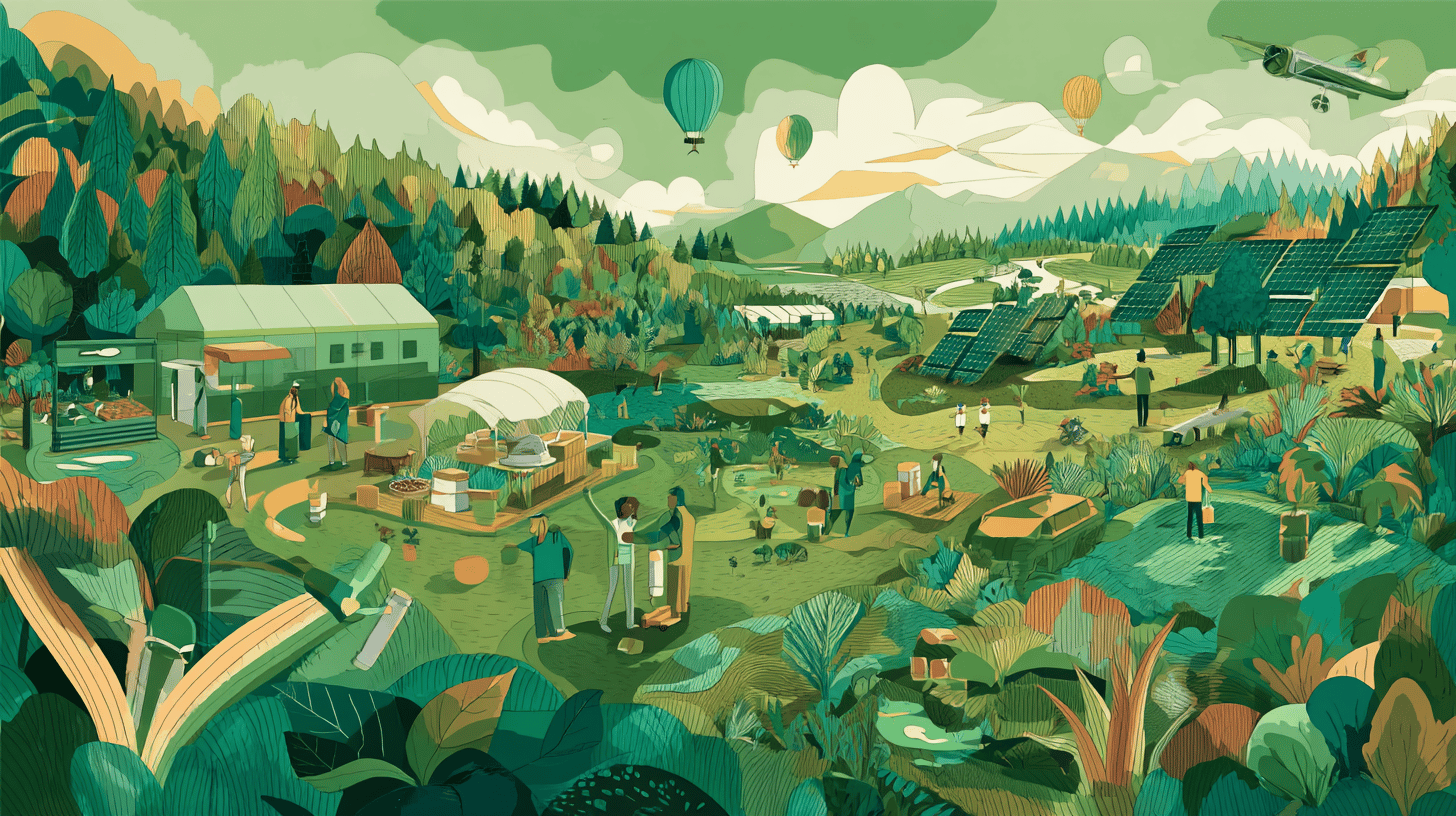Nos últimos anos, a conscientização sobre a necessidade de um estilo de vida mais sustentável tem crescido exponencialmente. Com as mudanças climáticas se tornando uma realidade inegável e a biodiversidade em risco, é fundamental que cada um de nós faça a sua parte para reduzir a nossa pegada ecológica. Neste post, vamos explorar práticas sustentáveis que podem ser incorporadas ao nosso cotidiano em 2025, oferecendo um guia prático e acessível para quem deseja contribuir positivamente para o meio ambiente.
Entendendo a Sustentabilidade
A sustentabilidade se refere à capacidade de atender às necessidades do presente sem comprometer a capacidade das futuras gerações de atender às suas próprias necessidades. Ela abrange aspectos sociais, econômicos e ambientais, e a sua prática pode se manifestar de diversas formas no dia a dia. Com pequenas mudanças, podemos fazer uma enorme diferença.
Reduzindo o Consumo de Plástico
Um dos maiores desafios ambientais atuais é a poluição por plástico. Estima-se que milhões de toneladas de plástico são despejadas nos oceanos a cada ano, afetando a vida marinha e, consequentemente, os seres humanos. Uma forma eficaz de reduzir o consumo de plástico é optar por produtos reutilizáveis e evitar itens descartáveis. Aqui estão algumas sugestões:
– Utilize Garrafas Reutilizáveis: Automóveis de água, por exemplo, ajudam a reduzir a necessidade de comprar garrafas plásticas descartáveis. Isso não só diminui a poluição, mas também economiza dinheiro.
– Evite Sacolas Plásticas: Leve sacolas de pano ou de material reciclável quando for às compras. Essa simples troca pode resultar em uma redução significativa do plástico que vai para os aterros sanitários.
– Prefira Produtos com Menos Embalagem: Sempre que possível, escolha produtos que tenham pouca ou nenhuma embalagem plástica. Isso pode incluir comprar a granel ou escolher marcas que usam embalagens sustentáveis.
Adotando uma Alimentação Sustentável
A forma como nos alimentamos tem um enorme impacto no meio ambiente. A indústria da carne, por exemplo, é uma das maiores responsáveis pela emissão de gases de efeito estufa e pelo desmatamento. Aqui estão algumas maneiras de adotar uma dieta mais sustentável:
– Considere uma Dieta Baseada em Plantas: Reduzir o consumo de carne e laticínios não só é benéfico para a saúde, mas também para o meio ambiente. Experimente incluir mais vegetais, grãos integrais e leguminosas em suas refeições diárias.
– Compre Alimentos Locais e Sazonais: Produtos que são cultivados localmente têm uma pegada de carbono muito menor em comparação com aqueles que são transportados de longas distâncias. Além disso, apoiar os agricultores locais traz benefícios à economia da região.
– Evite Alimentos Processados: Alimentos processados geralmente têm uma embalagem excessiva e exigem mais recursos para serem produzidos. Opte por alimentos frescos e minimamente processados sempre que possível.
Economizando Água
A água é um recurso precioso que deve ser utilizado de maneira consciente. Pequenas mudanças na rotina diária podem resultar em uma grande economia. Algumas dicas incluem:
– Instale Aeradores nas Torneiras: Com esses dispositivos, você pode reduzir o fluxo de água sem comprometer a pressão.
– Tomar Banhos Mais Curtos: Reduzir o tempo que você passa no chuveiro pode economizar litros de água. Uma boa meta é tentar limitar os banhos a cinco minutos.
– Reutilize Água: Coletar água da chuva ou reutilizar água de cozinha (como a água de cozimento de vegetais) para regar plantas são ótimas maneiras de conservar este recurso.
Adotando Práticas de Transporte Sustentável
O transporte é uma das principais fontes de emissão de carbono. Alterar a forma como nos deslocamos pode fazer uma grande diferença. Aqui estão algumas sugestões:
– Utilize Transporte Público: Sempre que possível, prefira ônibus, trens ou metrôs ao invés de veículos particulares. Isso não só reduz as emissões de carbono, mas também diminui o tráfego nas cidades.
– Experimente o Carona Compartilhada: Ao compartilhar um carro com outras pessoas, você não apenas economiza combustível, mas também diminui as emissões de poluentes.
– Opte por Bicicletas ou Caminhadas: Para trajetos curtos, andar de bicicleta ou mesmo a pé é uma ótima opção. Isso melhora a saúde e reduz a pegada ecológica.
Incentivando a Educação Ambiental
Outro aspecto fundamental de um estilo de vida sustentável é a educação. Ao se informar e compartilhar conhecimento, você pode impactar positivamente a comunidade ao seu redor:
– Participe de Atividades Educativas: Envolver-se em workshops ou cursos sobre sustentabilidade pode aumentar a sua conscientização e habilidades práticas.
– Compartilhe Conhecimento: Converse com amigos e familiares sobre práticas sustentáveis. Quanto mais pessoas se envolverem, maior será o impacto coletivo.
– Apoie Iniciativas Locais: Muitas vezes, comunidades têm projetos voltados para a sustentabilidade. Participe e ajude a promover mudanças positivas em sua cidade ou bairro.
Investindo em Energias Renováveis
A dependência de combustíveis fósseis é uma das principais causas da degradação ambiental. Investir em energias renováveis pode ser uma maneira eficaz de reduzir nossa contribuição para essa crise:
– Instale Painéis Solares: Se você possui uma casa, investir em energia solar pode reduzir significativamente a sua conta de energia, fazendo com que você dependa menos de fontes de energia não renováveis.
– Considere Fornecedores de Energia Verde: Muitas empresas oferecem energia gerada a partir de fontes renováveis. Mudar para um desses fornecedores é uma maneira fácil de minimizar seu impacto ambiental.
Envolvendo-se em Ações Coletivas
Ser parte de iniciativas em grupo pode maximizar o impacto das ações sustentáveis. Aqui estão algumas formas de se envolver:
– Participe de Limpezas Locais: Muitas cidades organizam eventos para limpar praias, parques ou outras áreas. Participar dessas atividades demonstra compromisso e promove uma comunidade mais saudável.
– Crie ou Junte-se a Grupos de Defesa Ambiental: Atuar em conselhos locais ou organizações voltadas para a proteção ambiental pode ajudar a levar mudanças de forma efetiva.
Sustentabilidade Financeira
Por último, mas não menos importante, entender como investimentos sustentáveis podem fazer parte do seu portfólio é crucial. Isso envolve:
– Investir em Empresas Verde: Apoiar empresas que priorizam a sustentabilidade nos modelos de negócios pode, além de ajudar o meio ambiente, gerar retorno financeiro a longo prazo.
– Considere Títulos Verdes: Esses títulos financiam projetos que têm um impacto positivo no meio ambiente. Investir neles é uma maneira de contribuir para a recuperação e proteção do mesmo.
Conclusão
Adotar um estilo de vida sustentável é mais do que uma responsabilidade individual; é uma necessidade coletiva. As práticas que discutimos são acessíveis e viáveis para muitas pessoas, e a implementação de cada uma delas pode levar a mudanças significativas para o meio ambiente. Que tal começar hoje mesmo? Escolha uma ou duas práticas da lista e comece a integrá-las na sua rotina. Com pequenos passos, podemos todos avançar rumo a um futuro mais verde e sustentável. Estamos juntos nessa jornada e, ao compartilharmos experiências e inspirações, podemos construir um mundo melhor para todos.
Convidamos você a deixar nos comentários suas ideias e práticas sustentáveis que adotou em sua vida. Vamos compartilhar conhecimento e inspirar uns aos outros a fazer a diferença!



